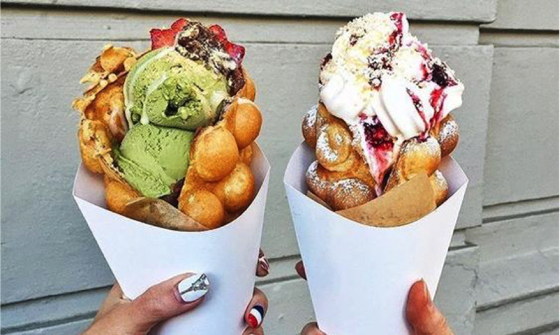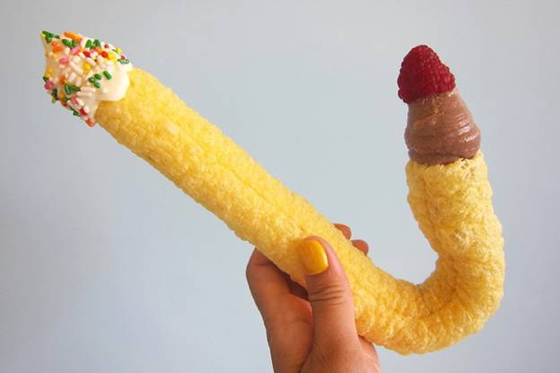Here’s the scoop on scoping out what’s happening with frozen desserts, according to Michael Whiteman of Baum+Whiteman International Restaurant Consultants, New York. Look to the Far East for the hottest trends. Places like Singapore, Hong Kong, Manila, Japan and New Delhi, where they know about torrid, horrid and humid days.
Bubble waffle ice cream cones. Not your standard waffle cone, this old favorite Hong Kong street food has been reinvented as a warm puffy ice cream cone with all manner of inventive fillings. The clash of warm and cold is irresistible. And they’re spectacular looking.
Find them at Eggloo and Wowfulls in New York, Cauldron Ice Cream in Santa Ana, California, Bubble Wrap and Nosteagia in London, Bang Bang Ice Cream in Toronto. They’re also called Eggettes, Puffy Egg Waffles or Puffle Cones in some places, and gai daan jai in Hong Kong.
They come in various flavors (like matcha tea or chocolate) and people compete to see who can assemble the most outlandish looking ice cream dessert, using everything from pocky sticks to Oreos to fruity pebbles.
The question is how long does this trend last? Beyond the rest of the summer, certainly. We’ve seen some franchises for sale, which may be a warning sign about whether the bubble waffle is in fact another bubble, or whether it will be co-opted by the big ice cream companies.

Unicorns and rainbows: Still alive but going black? The global obsession with food that looks like a tie-dyed t-shirt hasn’t quite subsided. But there’s a counter-reaction to this nonsense and it is equally nonsensical: Black desserts.
Maybe it all began when Burger King and McDonald’s in 2014 unleashed black hamburger buns (stained with squid ink) upon the poor citizens of Tokyo. Now the Darth Vader approach to dining has brought forth several renditions of black ice cream and soft-serve, and even cones. These latest travesties get their color from activated charcoal or charred coconut husks (yes, there’s some medical controversy about whether this is good for you or bad), or from black bean paste or licorice.
Their origin is Japan, but should you enjoy strolling down Main Street with blackened teeth, then find this sort of voodoo food at Little Damage Ice Cream in Los Angeles; at Buza in Jerusalem where the color comes, they say, from zinc; Sour Sally in Jakarta; maybe at the ever- inventive Morgenstern’s in New York; at Ca Lem in Montreal; or Sticks’n’Sushi in London. But hurry, this trendlet for sure will melt down.
Two toasts of the town.
1. Shibuya Honey Toast: Honey toast originated in Japan, then spread to Singapore, Bangkok and Taiwan. It is little more than a four-inch block of hollowed-out white bread that’s been basted with honey and (sometimes) sweetened condensed milk, and then baked until warm and crispy. The hollowed out portion of bread is cut into smaller cubes and also thus baked. Then the block is filled with the cubes and all manner of ice cream and/or fruit and/or whipped cream and various optional excesses. Honey Toast – also called Brick Toast – has made only modest inroads in the U.S. and certainly hasn’t gone mainstream. But it could. See Cafe LaTTea and Akiba in San Francisco, Oh My Pan in Cupertino, California, Pang Pin in Las Vegas and SohoTea Room in Vancouver. The Starbucks-like Caffe Bene chain in the U.S. serves a simplified but less engaging version.
2. Oozing Lava Toast: Say hello to the NextGen molten chocolate cake. Similar to Honey Toast and the rage in Singapore and Bangkok last year, this concoction is filled with a semi-liquid and topped with a ball of ice cream. When one of the toast’s walls is demolished, out flows the filling, which could be melted chocolate or whipped cream cheese, or green tea. Sometimes, the slabs of bread are replaced by cubes of bread or cake. It also comes in savory versions with fillings like curry and salted egg sauce – flavors clearly less applicable here, but it could be converted to the equivalent of an open-face chicken pot pie.

Legally injectable pleasures. In Seoul, customers are mainlining flavors into their desserts using plastic syringes. It’s a bit of a fad there, if not a full-blown trend. The idea is that you can add a customized flavor boost to ice cream or soft serve – most often nitro-chilled ice cream. And it involves the customer in the creation of the product.
The idea’s popping up around the world. In Florida, Brain Freeze has syringes filled with condensed milk, guava sauce, caramel sauce and chocolate. They spike up already flavorfully inventive nitro-ice creams and soft serves, and also allow you to build your own fantasy combinations. In Sydney, you’ll find much the same at N2 Extreme Gelato. In Manila, go to Outre´ for your injection. In Delhi, get your fix at Niice Cream.
Four quickies.
1. Rolled Ice Cream, which is also called Fried Ice Cream, a product out of Bangkok that’s popping up in cities around the U.S. Do a Google search.
2. Fresh honey comb, another Korean concept, is hot in Singapore and other torrid cities. You most often get chunks of it with soft serve.
3. Cotton candy toppings for ice cream cones and sundaes seem to be gaining traction.
4. J-shaped cones are getting some media attention. They’re hollow, made of corn, and filled with soft- serve. Allegedly the shape reduces the chances of dripping.

